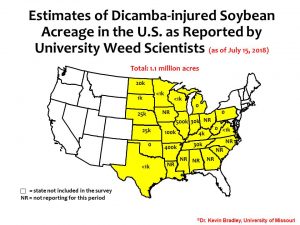Zhang et al., 2019b
Zhang, J., Huang, Y., Reddy, K. N., & Wang, B.; “Assessing crop damage from dicamba on non-dicamba-tolerant soybean by hyperspectral imaging through machine learning;” Pest Management Science, 2019, 75(12), 3260-3272; DOI: 10.1002/ps.5448.
ABSTRACT:
BACKGROUND: Dicamba effectively controls several broadleaf weeds. The off-target drift of dicamba spray or vapor drift can cause severe injury to susceptible crops, including non-dicamba-tolerant crops. In a field experiment, advanced hyperspectral imaging (HSI) was used to study the spectral response of soybean plants to different dicamba rates, and appropriate spectral features and models for assessing the crop damage from dicamba were developed.
RESULTS: In an experiment with six different dicamba rates, an ordinal spectral variation pattern was observed at both 1 week after treatment (WAT) and 3 WAT. The soybean receiving a dicamba rate >/=0.2X exhibited unrecoverable damage. Two recoverability spectral indices (HDRI and HDNI) were developed based on three optimal wavebands. Based on the Jeffries-Matusita distance metric, Spearman correlation analysis and independent t-test for sensitivity to dicamba spray rates, a number of wavebands and classic spectral features were extracted. The models for quantifying dicamba spray levels were established using the machine learning algorithms of naive Bayes, random forest and support vector machine.
CONCLUSIONS: The spectral response of soybean injury caused by dicamba sprays can be clearly captured by HSI. The recoverability spectral indices developed were able to accurately differentiate the recoverable and unrecoverable damage, with an overall accuracy (OA) higher than 90%. The optimal spectral feature sets were identified for characterizing dicamba spray rates under recoverable and unrecoverable situations. The spectral features plus plant height can yield relatively high accuracy under the recoverable situation (OA = 94%). These results can be of practical importance in weed management. (c) 2019 Society of Chemical Industry.

